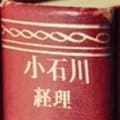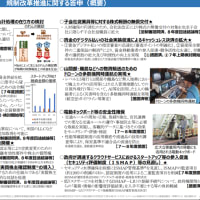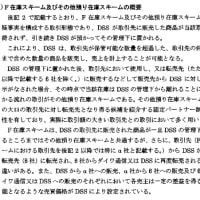新しいCOSOフレームワークが、5月14日に公表されたという記事。
An important development in the internal control landscape was completed Tuesday with the release of an update to the integrated framework of the Committee of Sponsoring Organizations of the Treadway Commission (COSO).
COSOの旧フレームワークは1992年に公表され、SOX法で求められている、内部統制の証明のためのフレームワークとして、SECが認めているものです。新バージョンでも、5つの構成要素は引き続きフレームワークの基礎となっています。
COSO’s popular original internal control framework, released in 1992, was accepted by the SEC as a framework for attesting to internal control over financial reporting as required by the Sarbanes-Oxley Act of 2002 (SOX). And the five main components of the original framework―control environment, risk assessment, control activities, information and communication, and monitoring activities―remain the foundation for the updated framework.
新フレームワークの最も重要な変更点は、5つの構成要素にわたって、17の原則が設けられたことです。
The most significant new development in COSO’s new framework is the articulation of 17 specific principles spread across the five main components of internal control. As in the past, the five components need to be functioning―and functioning together―for internal control to be present.
各原則には、原則に示された事項が存在し機能しているかどうかを評価するのに役立つ「注目点」が付されています。
Each principle is accompanied by explicit points of focus designed to help users evaluate whether the principle is present and functioning. Although some points of focus don’t apply to all users and all situations, they will help organizations understand with greater specificity the way the more general principles are supposed to be evaluated.
新フレームワークは、現在の事業環境の重要な部分となっているテクノロジーとグローバル化をよりよく反映したものです。フレームワークの適用に役立つ2つの付属文書も同時に公表されました。
The new framework better reflects the technology and globalization that have become an increasingly important part of the current business environment. And the framework is being released with two accompanying documents that will help aid implementation.
旧フレームワークは、2014年12月15日に終了する経過期間において、有効です。その時点で、旧フレームワークの廃止を検討するとのことです。
Officials with COSO say that although the new framework is an improvement, the 1992 version remains appropriate and relevant for a transition period that will end Dec. 15, 2014. At that time, COSO will consider the 1992 framework superseded.
米国上場会社には影響がありそうな改正です。日本の内部統制基準の改正に結び付くかどうかは、よくわかりません。
こちらのページから、購入できるようです。サマリーは無料でダウンロードできます。
Guidance on Internal Control(COSO)
17の原則は以下のとおりです。5つの構成要素ごとに列挙されています。(不正確なところもあると思いますが、仮の訳を付けてみました。「・・・している」と訳しましたが、原則なので、「「・・・している」という状態にならなければならない」というニュアンスを含んでいます。重要なフレームワークなので、そのうちに専門家によるちゃんとした翻訳書が出るでしょう。)
Control Environment 統制環境
1. The organization demonstrates a commitment to integrity and ethical values.
組織は誠実性と倫理的価値へのコミットメントを明らかに示している。
2. The board of directors demonstrates independence from management and exercises oversight of the development and performance of internal control.
取締役会はマネジメントからの独立性を明らかに示しており、また、内部統制の開発と実施に対する監視を実施している。
3. Management establishes, with board oversight, structures, reporting lines, and appropriate authorities and responsibilities in the pursuit of objectives.
マネジメントは、目標の追求において、組織構造、報告ラインおよび適切な権限と責任を、幅広い監督を行いつつ確立している。
4. The organization demonstrates a commitment to attract, develop, and retain competent individuals in alignment with objectives.
組織は、目標と整合した有能な人材を、引きつけ、開発し、保持するというコミットメントを明らかに示している。
5. The organization holds individuals accountable for their internal control responsibilities in the pursuit of objectives.
組織は、目標の追求において、各個人が内部統制責任に関して説明責任を負うようにしている。
Risk Assessment リスク評価
6. The organization specifies objectives with sufficient clarity to enable the identification and assessment of risks relating to objectives.
組織は、目標に関連するリスクの識別と評価ができるだけの十分な明瞭性をもって目標を特定している。
7. The organization identifies risks to the achievement of its objectives across the entity and analyzes risks as a basis for determining how the risks should be managed.
組織は、組織目標の達成へのリスクを企業全体にわたって識別し、リスク管理の方法を決定する基礎として分析している。
8. The organization considers the potential for fraud in assessing risks to the achievement of objectives.
組織は、目標達成へのリスクを評価するにあたり、不正の可能性を検討している。
9. The organization identifies and assesses changes that could significantly impact the system of internal control.
組織は、内部統制のシステムに重要な影響を与え得る変化を、識別し評価している。
Control Activities 統制活動
10. The organization selects and develops control activities that contribute to the mitigation of risks to the achievement of objectives to acceptable levels.
組織は、目標達成へのリスクを受容できる水準まで軽減するのに貢献する統制活動を選択し開発している。
11. The organization selects and develops general control activities over technology to support the achievement of objectives.
組織は、目標達成をサポートするテクノロジーに対する全般的統制活動を選択し開発している。
12. The organization deploys control activities through policies that establish what is expected and procedures that put policies into action.
組織は、何が期待されているのかを定めた方針と、方針を実行する手続によって、統制活動を展開している。
Information and Communication 情報とコミュニケーション
13. The organization obtains or generates and uses relevant, quality information to support the functioning of internal control.
組織は、統制活動をサポートする、関連性のある質の高い情報を、入手または生成し、使用している。
14. The organization internally communicates information, including objectives and responsibilities for internal control, necessary to support the functioning of internal control.
組織は、内部統制の目標と責任を含む、内部統制が機能するのに必要な情報を内部的に伝達している。
15. The organization communicates with external parties regarding matters affecting the functioning of internal control.
組織は、内部統制が機能することに影響を与える事項に関して、外部関係者との間で、コミュニケーションを行っている。
Monitoring Activities 監視活動
16. The organization selects, develops, and performs ongoing and/or separate evaluations to ascertain whether the components of internal control are present and functioning.
組織は、内部統制の構成要素が現存し機能しているかどうかを確かめるための、継続的な、かつ/または、個別的な、評価を、選択し開発し実施している。
17. The organization evaluates and communicates internal control deficiencies in a timely manner to those parties responsible for taking corrective action, including senior management and the board of directors, as appropriate.
組織は、内部統制の不備をタイムリーに評価し、シニア・マネジメントや取締役会を含む、是正措置を講ずる責任を有する関係者に対して、タイムリーに伝達している。
8 steps to update internal control(JofA)
最近の「内部統制」カテゴリーもっと見る
最近の記事
カテゴリー
バックナンバー
2000年
人気記事




